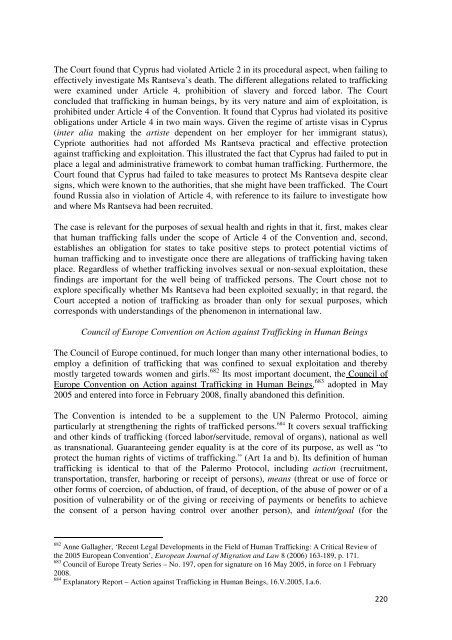Johanna Westeson - The ICHRP
Johanna Westeson - The ICHRP
Johanna Westeson - The ICHRP
You also want an ePaper? Increase the reach of your titles
YUMPU automatically turns print PDFs into web optimized ePapers that Google loves.
<strong>The</strong> Court found that Cyprus had violated Article 2 in its procedural aspect, when failing to<br />
effectively investigate Ms Rantseva’s death. <strong>The</strong> different allegations related to trafficking<br />
were examined under Article 4, prohibition of slavery and forced labor. <strong>The</strong> Court<br />
concluded that trafficking in human beings, by its very nature and aim of exploitation, is<br />
prohibited under Article 4 of the Convention. It found that Cyprus had violated its positive<br />
obligations under Article 4 in two main ways. Given the regime of artiste visas in Cyprus<br />
(inter alia making the artiste dependent on her employer for her immigrant status),<br />
Cypriote authorities had not afforded Ms Rantseva practical and effective protection<br />
against trafficking and exploitation. This illustrated the fact that Cyprus had failed to put in<br />
place a legal and administrative framework to combat human trafficking. Furthermore, the<br />
Court found that Cyprus had failed to take measures to protect Ms Rantseva despite clear<br />
signs, which were known to the authorities, that she might have been trafficked. <strong>The</strong> Court<br />
found Russia also in violation of Article 4, with reference to its failure to investigate how<br />
and where Ms Rantseva had been recruited.<br />
<strong>The</strong> case is relevant for the purposes of sexual health and rights in that it, first, makes clear<br />
that human trafficking falls under the scope of Article 4 of the Convention and, second,<br />
establishes an obligation for states to take positive steps to protect potential victims of<br />
human trafficking and to investigate once there are allegations of trafficking having taken<br />
place. Regardless of whether trafficking involves sexual or non-sexual exploitation, these<br />
findings are important for the well being of trafficked persons. <strong>The</strong> Court chose not to<br />
explore specifically whether Ms Rantseva had been exploited sexually; in that regard, the<br />
Court accepted a notion of trafficking as broader than only for sexual purposes, which<br />
corresponds with understandings of the phenomenon in international law.<br />
Council of Europe Convention on Action against Trafficking in Human Beings<br />
<strong>The</strong> Council of Europe continued, for much longer than many other international bodies, to<br />
employ a definition of trafficking that was confined to sexual exploitation and thereby<br />
mostly targeted towards women and girls. 682 Its most important document, the Council of<br />
Europe Convention on Action against Trafficking in Human Beings, 683 adopted in May<br />
2005 and entered into force in February 2008, finally abandoned this definition.<br />
<strong>The</strong> Convention is intended to be a supplement to the UN Palermo Protocol, aiming<br />
particularly at strengthening the rights of trafficked persons. 684 It covers sexual trafficking<br />
and other kinds of trafficking (forced labor/servitude, removal of organs), national as well<br />
as transnational. Guaranteeing gender equality is at the core of its purpose, as well as “to<br />
protect the human rights of victims of trafficking.” (Art 1a and b). Its definition of human<br />
trafficking is identical to that of the Palermo Protocol, including action (recruitment,<br />
transportation, transfer, harboring or receipt of persons), means (threat or use of force or<br />
other forms of coercion, of abduction, of fraud, of deception, of the abuse of power or of a<br />
position of vulnerability or of the giving or receiving of payments or benefits to achieve<br />
the consent of a person having control over another person), and intent/goal (for the<br />
682 Anne Gallagher, ‘Recent Legal Developments in the Field of Human Trafficking: A Critical Review of<br />
the 2005 European Convention’, European Journal of Migration and Law 8 (2006) 163-189, p. 171.<br />
683 Council of Europe Treaty Series – No. 197, open for signature on 16 May 2005, in force on 1 February<br />
2008.<br />
684 Explanatory Report – Action against Trafficking in Human Beings, 16.V.2005, I.a.6.<br />
220
















